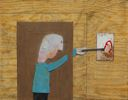Kirk Hayes does not have an image.
Kirk Hayes
American, b. 1958
On the surface, Kirk Hayes' compositions appear to be collages of torn paper, corrugated cardboard, yellowing masking tape, or scraps of plywood, however these illusory scenes are created by the artist's hand through a self-taught process of using oil paint to imitate collage. Although Hayes' method of painting is distinctly contemporary, the artist draws reference from thousands of years of art history, from Renaissance masterpieces to Roman mural painting, through both his trompe l'oeil technique and through his historical allusions. In a contrasting vein to First-Style Pompeian frescoes, in which Roman painters sought to create the illusion of expensive marble with lesser materials, Hayes seeks to create the illusion of lower-grade materials with the use of oil paints, duping the viewer’s eye on the surface.
Hayes' paintings are lightly sinister; the scenes and actions represented are beautifully simple, such as a Monarch butterfly landing on a knife's edge or a man dancing on a chair, yet they often portray a darker tone. Five cartoonish, smiling worms crawl through a decaying skull in Happy Worms, where Hayes refers to the classic vanitas motif, reminding us that death is inescapable. Napoleon In The Russian Snow, shows the infamous French general slumped over his white stallion, buried deep in a stale field of bloodied snow. In contrast to Jacques-Louis David's idealized portrait of the French Emperor crossing the Alps, Hayes imagines the portrait after Napoleon's unsuccessful invasion into Russia, veraciously portraying a defeated, lifeless body rather than the triumphant hero that is traditionally recognized in art history. Hayes lives and works in Fort Worth, TX.
Source: http://hortongallery.com/artist/kirkhayes
American, b. 1958
On the surface, Kirk Hayes' compositions appear to be collages of torn paper, corrugated cardboard, yellowing masking tape, or scraps of plywood, however these illusory scenes are created by the artist's hand through a self-taught process of using oil paint to imitate collage. Although Hayes' method of painting is distinctly contemporary, the artist draws reference from thousands of years of art history, from Renaissance masterpieces to Roman mural painting, through both his trompe l'oeil technique and through his historical allusions. In a contrasting vein to First-Style Pompeian frescoes, in which Roman painters sought to create the illusion of expensive marble with lesser materials, Hayes seeks to create the illusion of lower-grade materials with the use of oil paints, duping the viewer’s eye on the surface.
Hayes' paintings are lightly sinister; the scenes and actions represented are beautifully simple, such as a Monarch butterfly landing on a knife's edge or a man dancing on a chair, yet they often portray a darker tone. Five cartoonish, smiling worms crawl through a decaying skull in Happy Worms, where Hayes refers to the classic vanitas motif, reminding us that death is inescapable. Napoleon In The Russian Snow, shows the infamous French general slumped over his white stallion, buried deep in a stale field of bloodied snow. In contrast to Jacques-Louis David's idealized portrait of the French Emperor crossing the Alps, Hayes imagines the portrait after Napoleon's unsuccessful invasion into Russia, veraciously portraying a defeated, lifeless body rather than the triumphant hero that is traditionally recognized in art history. Hayes lives and works in Fort Worth, TX.
Source: http://hortongallery.com/artist/kirkhayes
Artist Objects
Mood Swing 2018.003
Painter 2014.006

